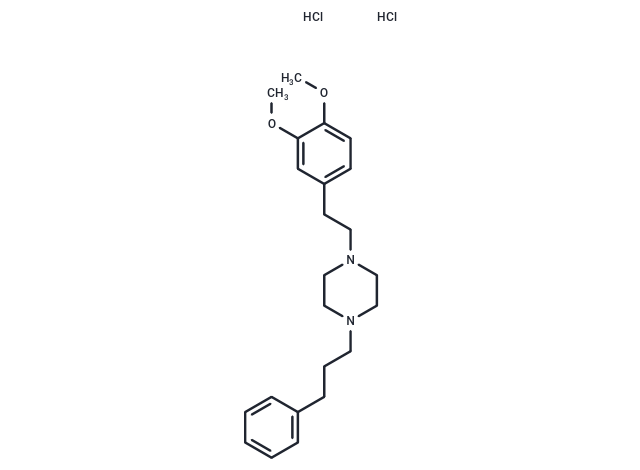Shopping Cart
- Remove All
 Your shopping cart is currently empty
Your shopping cart is currently empty

Cutamesine dihydrochloride (SA4503 dihydrochloride) is a selective σ1 receptor agonist (IC50: 17.4 nM). It shows selectivity for σ1 over σ2 receptors, and inhibits angiotensin II-induced cardiomyocyte hypertrophy in vitro and attenuates myocardial hypertrophy in vivo. In a rat model of experimental stroke, it enhances brain plasticity and sensorimotor function.

| Pack Size | Price | Availability | Quantity |
|---|---|---|---|
| 2 mg | $32 | In Stock | |
| 5 mg | $50 | In Stock | |
| 10 mg | $88 | In Stock | |
| 25 mg | $188 | In Stock | |
| 50 mg | $296 | In Stock | |
| 100 mg | $469 | In Stock | |
| 200 mg | $673 | In Stock | |
| 1 mL x 10 mM (in DMSO) | $55 | In Stock |
| Description | Cutamesine dihydrochloride (SA4503 dihydrochloride) is a selective σ1 receptor agonist (IC50: 17.4 nM). It shows selectivity for σ1 over σ2 receptors, and inhibits angiotensin II-induced cardiomyocyte hypertrophy in vitro and attenuates myocardial hypertrophy in vivo. In a rat model of experimental stroke, it enhances brain plasticity and sensorimotor function. |
| Targets&IC50 | σ1:17.4 nM |
| In vitro | The sigma receptor is implicated in various central nervous system diseases. SA4503, a potent σ1 receptor agonist, exhibits a 103-fold higher affinity for σ1 (IC50=17.4 nM) than σ2 (IC50=1,784 nM) in guinea pig brain membranes and is 14-fold selective for σ1 (Ki=4.6 nM) over σ2 (Ki=63.1 nM) in guinea pig brain homogenates[1]. SA4503 protects motor neuron NSC34 cells against superoxide dismutase 1 and serum-free neurotoxicity, upregulating phosphorylation levels of Akt and extracellular signal-regulated kinase (ERK) 1/2[2], while reducing MAPK/ERK pathway activation and down-regulating the ionotropic glutamate receptor, GluR1[3]. |
| In vivo | SA4503 extends the survival time in the SOD1 g93A mice[2]. |
| Cell Research | The NSC34 cells are seeded at a density of 7000 cells per well into 96-well plates with D-MEM and transfected using Lipofectamine 2000 mixed with 2 μg /mL of plasmid vector in D-MEM for 6 h. After 6 h, the cell-culture medium is replaced with fresh D-MEM and culture and allowed to proceed for a further 42 h. The cells are then transferred to serum-free D-MEM and immediately treated with SA4503 at a final concentration of 1, 3, or 10 nM[2]. |
| Alias | SA4503 dihydrochloride, SA4503 (dihydrochloride), AGY94806 dihydrochloride |
| Molecular Weight | 441.43 |
| Formula | C23H32N2O2·2HCl |
| Cas No. | 165377-44-6 |
| Smiles | Cl.Cl.COc1ccc(CCN2CCN(CCCc3ccccc3)CC2)cc1OC |
| Relative Density. | no data available |
| Storage | Powder: -20°C for 3 years | In solvent: -80°C for 1 year | Shipping with blue ice. | |||||||||||||||||||||||||
| Solubility Information | DMSO: 10 mg/mL (22.65 mM), Sonication and heating are recommended. | |||||||||||||||||||||||||
Solution Preparation Table | ||||||||||||||||||||||||||
DMSO
| ||||||||||||||||||||||||||

Copyright © 2015-2025 TargetMol Chemicals Inc. All Rights Reserved.